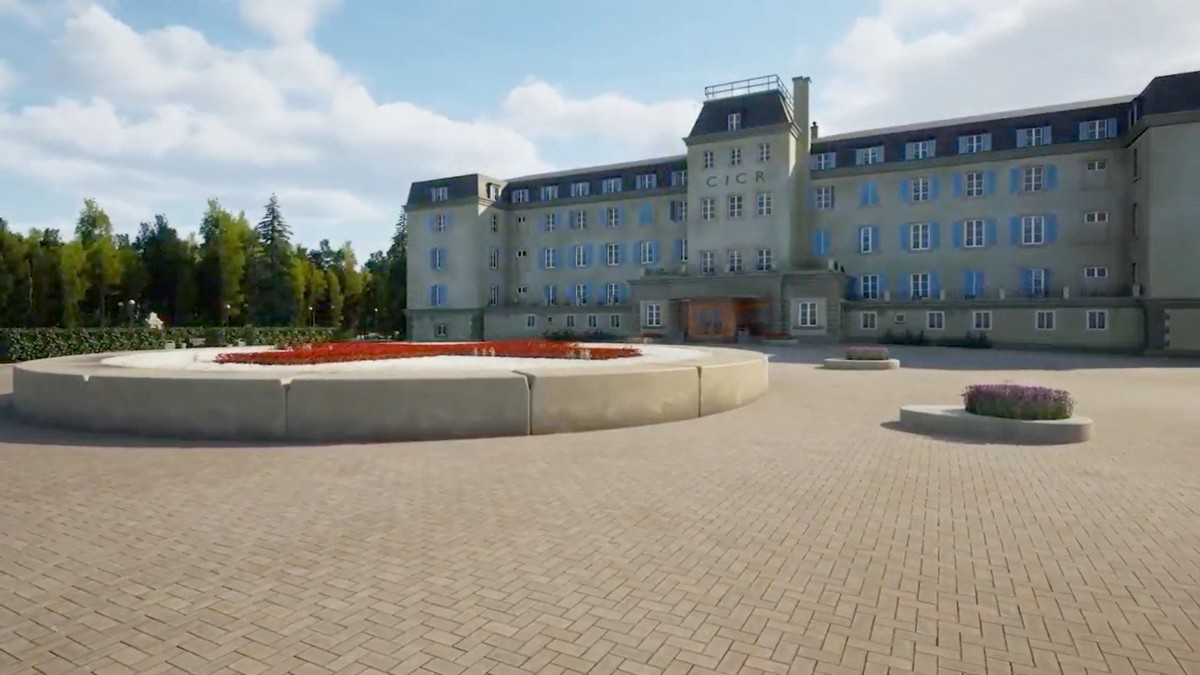What if a major humanitarian organization created its own virtual environment offering immersive, video game-style trainings to anyone using a standard laptop anywhere in the world – all at minimal cost?
Welcome to the ICRC’s Mirror World, a digital twin of the 160-year-old institution.
Developed jointly by the ICRC’s Virtual Reality Unit (VRU) and the Innovation Team, this online training ecosystem replicates an ICRC operating environment. Since 2012, the VRU has been creating scenarios and virtual worlds for ICRC teams. With the Mirror World, all these worlds are coming together in one platform.
Within the ICRC Mirror World exists a complete and functioning city, featuring homes, places of worship, shopping centres, schools, hospitals and utility structures, all ready to be used or recycled into new, additional trainings.
Current virtual training grounds within the Mirror World include a camp for displaced people, a prison, an urban combat simulation (a specific interaction between soldiers and civilians) and a 500-bed hospital plus morgue.
“Our goal for this initiative was to create a better training environment, one that is more accessible for our staff, more cost-efficient for the institution, and makes the most of the numerous benefits that come from immersive technologies,” says ICRC Innovation & Foresight Adviser Melissa Kiehl.
The starting point for all entrants to the Mirror World is the courtyard in front of the historic Carlton building at ICRC headquarters in Geneva. This particular entry point serves as a meeting area and forum for anything from private conversations to townhall discussions.
“The Carlton building is a notable structure for the ICRC,” says Christian Rouffaer, head of the VRU. “It was important for us to include it within the Mirror World as a cultural touchstone.”
The ICRC used Epic Games’ Unreal Engine platform to design the Mirror World, so users have the same operability as a video game, such as designing personalized avatars, communicating privately or publicly, or changing the weather conditions.
This video game style and format, what’s known as an “open sandbox”, means that participants are free to roam within the Mirror World. Like a video game, you can pick a location on the map, and either be transported directly there, or you can walk, run or drive, using an ICRC Land Cruiser.
Realistic simulations
Stephen Kilpatrick, military and armed groups adviser at the ICRC, has been using virtual reality tools to support IHL training for several years. He says the urban warfare simulations seen in the Mirror World offer greater possibilities and more realism than ever before.
“You can make it do whatever you want. If you want to focus on the impact of urban warfare on children or people with disabilities, you can simulate that,” explains Kilpatrick.
“The potential is huge because we can combine many different scenarios inside our Mirror World. The challenge now is to get all ICRC branches to understand that potential and capitalize on it.”
Alain Court, the ICRC’s learning solutions manager, also sees great potential in the Mirror World. He believes it can provide “a backbone for the ICRC learning journey”, a place that staff can continuously connect with.
In this regard, he says it can also be a space where people meet virtually outside face-to-face training sessions to engage in the peer exchanges that are a key part of learning.

The Carlton building inside the Mirror World.
Rouffaer says the current iteration of the Mirror World represents a solid foundation, but it must continue to grow and evolve as the technology does, therefore improving and developing to fit user needs. New scenarios, trainings and cultural touchstones will continue to be developed with input from ICRC staff all over the world.
And as the internal structure of the Mirror World grows, it is conceivable that the ICRC will be able to share access to this world with its partners in the International Red Cross and Red Crescent Movement and among other humanitarian operators for cross-organizational trainings.
While there is no intention of entirely replacing face-to-face training, evidence shows that virtual training results are almost identical to in-person training. And given the ongoing impact of the global financial crisis and the need to find alternative, cost-effective solutions, the Mirror World may soon become a standard tool for training at the ICRC.
But this is about more than just training.
“Virtual environments are a way to capture decades of knowledge and expertise into an immersive experience for the next generation,” says Kiehl. “And we hope that in the future this type of technology can expand into other areas, like how we orient new staff or connect with our donors.”
For the VRU and Innovation Team, the coming months and years should be exciting as the ICRC continues to develop its digital twin.
